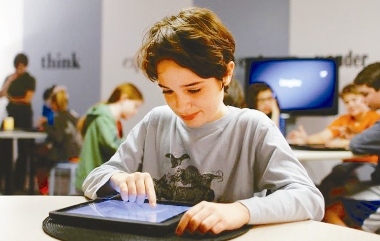 By Winnie Hu, The New York Times A growing number of schools across the nation are embracing the iPad as the latest tool in teaching. As part of a pilot program, Roslyn High School on Long Island handed out 47 iPads to the students and teachers in two humanities classes on December 20. The school district hopes to provide iPads eventually to all 1,100 of its students. The iPads cost US$750 each and are to be used in class and at home during the school year to replace textbooks, allow students to correspond with teachers and turn in papers and homework assignments, and preserve a record of student work in digital portfolios. “It allows us to extend the classroom beyond these four walls,” said Larry Reiff, an English teacher at Roslyn who now posts all his course material online. Technological fads have come and gone in schools, and other experiments meant to rev up the educational experience for children raised on video games and YouTube have had mixed results. Educators, for instance, are still divided over whether initiatives to give every student a laptop have made a difference academically. At a time when school districts are trying to get their budgets approved so they do not have to lay off teachers or cut programs, spending money on tablet computers may seem like an extravagance. Some parents and scholars have raised concerns that schools are rushing to invest in them before their educational value has been proved by research. “There is very little evidence that kids learn more, faster or better by using these machines,” said Larry Cuban, a professor emeritus of education at Stanford University, who believes that the money would be better spent to recruit, train and retain teachers. “IPads are marvelous tools to engage kids, but then the novelty wears off and you get into hard-core issues of teaching and learning.” But school leaders say the iPad is not just a cool new toy but rather a powerful and versatile tool with a multitude of applications, including thousands with educational uses. Educators also laud the iPad’s physical attributes, including its large touch screen (about 9.7 inches) and flat design, which allows students to maintain eye contact with their teachers. And students like its light weight, which offers a relief from the heavy books that weigh down their backpacks. Roslyn administrators also said the adoption of the iPad, for which the district paid US$56,250 for the initial 75 (32-gigabyte, with case and stylus), was advancing its effort to go paperless and cut spending. In Millburn, New Jersey, students at South Mountain Elementary School have used two iPads purchased by the parent-teacher organization to play math games, study world maps and read “Winnie the Pooh.” Scott Wolfe, the principal, said he hoped to secure 20 more iPads next school year to run apps that, for instance, simulate a piano keyboard on the screen or display constellations based on a viewer’s location. The New York City public schools have ordered more than 2,000 iPads, for US$1.3 million; 300 went to Kingsbridge International High School in the Bronx, or enough for all 23 teachers and half the students to use at the same time. | 
